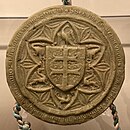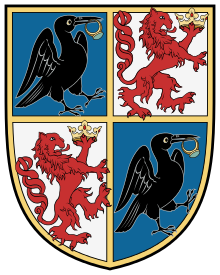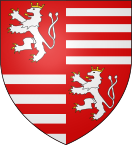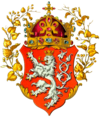Sigismund, Holy Roman Emperor
| Sigismund | |
|---|---|
Wenceslaus IV | |
| Successor | Albert |
| Born | 15 February 1368 Free Imperial City of Nuremberg, Holy Roman Empire |
| Died | 9 December 1437 (aged 69) Znojmo, Kingdom of Bohemia |
| Burial | Nagyvárad, Kingdom of Hungary (today Oradea , Romania) |
| Spouses | |
| Issue | Elizabeth of Luxembourg |
| House | Luxembourg |
| Father | Charles IV, Holy Roman Emperor |
| Mother | Elizabeth of Pomerania |
Sigismund of Luxembourg
Sigismund was the son of Charles IV, Holy Roman Emperor and his fourth wife Elizabeth of Pomerania. He married Mary, Queen of Hungary in 1385 and was crowned King of Hungary soon after. He fought to restore and maintain authority to the throne. Mary died in 1395, leaving Sigismund the sole ruler of Hungary.
In 1396, Sigismund led the
Historian Thomas Brady Jr. remarks that Sigismund "possessed a breadth of vision and a sense of grandeur unseen in a German monarch since the thirteenth century". He realized the need to carry out reforms of the empire and the Church at the same time. But external difficulties, self-inflicted mistakes and the extinction of the Luxembourg male line made this vision unfulfilled.
In recent years, scholarly interest (especially from
Biography
This section needs additional citations for verification. (September 2022) |
Early life
Born in

King
In 1381, the then 13-year-old Sigismund was sent to Kraków by his eldest half-brother and guardian Wenceslaus, King of Germany and Bohemia, to learn Polish and to become acquainted with the land and its people. King Wenceslaus also gave him Neumark to facilitate communication between Brandenburg and Poland.
While Mary was accepted as monarch of Hungary, Sigismund vied for the
King of Hungary

On the death of her father in 1382, his betrothed, Mary, became queen of Hungary and Sigismund married her in 1385 in Zólyom (today Zvolen). The next year, he was accepted as Mary's future co-ruler by the Treaty of Győr. However, Mary was captured, together with her mother, Elizabeth of Bosnia, who had acted as regent, in 1387 by the rebellious House of Horvat, Bishop Paul Horvat of Mačva, his brother John Horvat and younger brother Ladislav. Sigismund's mother-in-law was strangled, while Mary was liberated.

Having secured the support of the nobility, Sigismund was crowned
To ease the pressure from Hungarian nobles, Sigismund tried to employ foreign advisors, which was not popular, and he had to promise not to give land and nominations to anyone other than Hungarian nobles. However, this was not applied to Stibor of Stiboricz, who was Sigismund's closest friend and advisor. On a number of occasions, Sigismund was imprisoned by nobles, but with the help of the armies of Garai and Stibor of Stiboricz, he was able to regain power.
Crusade of Nicopolis


In 1396, Sigismund led the combined armies of Christendom against the Turks, who had taken advantage of the temporary helplessness of Hungary to extend their dominion to the banks of the
Return to Hungary


On his return to Hungary in 1401, Sigismund was imprisoned once and deposed twice. That year, he aided an uprising against
Due to his frequent absences attending to business in the other countries over which he ruled, he was obliged to consult Diets in Hungary with more frequency than his predecessors and institute the office of Palatine as chief administrator while he was away.[citation needed] In 1404, Sigismund introduced the Placetum Regium. According to this decree, Papal bulls could not be pronounced in Hungary without the consent of the king. During his long reign, the royal Buda Castle became probably the largest Gothic palace of the Late Middle Ages.[citation needed]
Crusade against Bosnia


In about 1406, Sigismund married Mary's cousin
Sigismund managed to establish control in Slavonia. He did not hesitate to use violent methods (see Bloody Sabor of Križevci), but from the River Sava to the south his control was weak. Sigismund personally led an army of almost 50,000 "crusaders" against the Bosnians, culminating with the Battle of Dobor in 1408, a massacre of about 200 members of various Bosnian noble families. However, although campaign militarily looked like a success, it ultimately failed politically and Hungarians retreated, while the Bosnian crown slowly but surely slipped away out of the reach for Sigismund and Hungarians.[14]
Possessions in Serbia
Threatened by Ottoman expansion, King Sigismund managed to strengthen the security of southern Hungarian borders by entering into a defensive alliance with Despot Stefan Lazarević of Serbia. In 1403, Hungarian possessions in northwestern regions of Serbia (city of Belgrade and the Banate of Macsó), were given to Despot Stefan, who pledged his allegiance to King Sigismund, remaining the king's loyal vassal until death in 1427. Stefan's successor George Branković of Serbia also pledged his allegiance to Sigismund, returning Belgrade to the king. By maintaining close relations with Serbian rulers, Sigismund succeeded in securing southern borders of his realm.[15][16]
Order of the Dragon
Sigismund founded his personal order of knights, the
King of the Romans
After the death of King
Anti-Polish alliances
On a number of occasions, and in 1410 in particular, Sigismund allied himself with the
Conference in Buda

In 1412, a Knights Tournament was held in
Council of Constance

From 1412 to 1423, Sigismund campaigned against the
When at one point during the council a cardinal corrected Sigismund's Latin, Sigismund replied Ego sum rex Romanus et super grammaticam ("I am king of the Romans and above grammar").[18] Thomas Carlyle nicknamed Sigismund "Super Grammaticam".[19][20]
His main acts during these years were an alliance with England against France, and a failed attempt, owing to the hostility of the princes, to secure peace in Germany by a league of the towns.[10] Also, Sigismund awarded Brandenburg (which he had recovered after Jobst's death) to Frederick of Hohenzollern, burgrave of Nuremberg, in 1415. This step made the House of Hohenzollern one of the most important in Germany.
Sigismund began to shift his alliance from France to England after the French defeat at the Battle of Agincourt, which he was also controversially absent from due to hosting a pseudo-council in Perpignan with Antipope Benedict XIII and King Ferdinand I of Aragon. The signing of the Treaty of Canterbury on 15 August 1416 culminated diplomatic efforts between Henry V of England and Sigismund and resulted in a defensive and offensive alliance against France. This, in turn, led the way to the resolution of the papal schism.[21] The close relationship that developed between Henry V and Sigismund resulted in him being inducted into the Order of the Garter.[22]
Hussite Wars


In 1419, the death of
The Bohemians, who distrusted him as the betrayer of Hus, were soon in arms; and the flame was fanned when Sigismund declared his intention of prosecuting the war against heretics. Three campaigns against the Hussites ended in disaster although the army of his most loyal ally Stibor of Stiboricz and later his son Stibor of Beckov could hold the Hussite side away from the borders of the kingdom. The Turks were again attacking Hungary.
At the 1422 Diet of Nuremberg, Sigismund and German territorial princes collaborated to organize two armies against the Hussite rebels. The first army was sent to relieve Karlštejn, which was under a Hussite siege; the second army was ordered to destroy the Hussite field army. But Jan Žižka defeated the Imperial force at the Battle of Kutná Hora and then at the Battle of Německý Brod. These two unexpected defeats at the hands of the Hussites "ended the first Imperial and Catholic attempt to crush the Bohemian 'heretic rebellion'."[23]
The alliance against the Hussites continued to develop though, joined by Upper German princes and cities, even from "the regions furthest from Bohemia". In January 1424, associative activity of the German electors led to the Union ('einunge') of Bingen, "within which the Rhenish princes were joined by the elector of Saxony and Sigismund's loyal partner Margrave Frederick of Brandenburg, and mutual assistance, adjudication, and cooperation in the face of the Hussite threat were stipulated."[24]
Germany
Sigismund's rule in Germany and in the empire in general was hampered by his complete lack of Hausmacht (domestic power) within the Kingdom of Germany.[5][25]
His rule relied on key allies and the culture of associative political mechanisms in Germany. Duncan Hardy remarks that, "both the local and the trans-regional dimensions of the political activity displayed by the sources from throughout Sigismund's reign demonstrate that power at every level in the empire was exercised and mediated through the customary institutions and mechanisms of associative political culture. If Sigismund enjoyed considerable successes at certain junctures, it was not in spite of or independently from these institutions and mechanisms, but precisely because he devoted considerable energy to harnessing associative interactions and building strategic relationships with leading actors within elite networks. Even during his prolonged absences from the empire's core lands, Sigismund was able to make use of these partnerships, and could reasonably expect that the associative activity of princes, nobles, and towns would yield results—as indeed they did, in the form of large-scale collective activity against Duke Frederick IV of Austria—Tyrol in the 1410 and the Hussites in the 1420. Not all of Sigismund's projects came to fruition, and he could not always control the longer-term outcomes of his policies, but the notion that there were phases of an 'empire without a king' during his reign clearly does not stand up to the abundant evidence of his interactions with regional clients and associations. At the same time, the somewhat adulatory view that has developed in recent years of Sigismund as a masterly politician can be tempered by the evidence that it was often felicitous alliances as much as personal skill which made his successes possible." [26]
The alliance between Sigismund and his two key allies in Germany, namely
Final years
In 1428, Sigismund led another campaign against the Turks, but again with few results. In 1431, he went to
Family and issue
Sigismund married twice but had little luck in securing the succession to his crowns. Each of his two marriages resulted in the birth of one child. His
Hungarian affiliations

Sigismund was known to speak fluent Hungarian, wore Hungarian-style royal clothes, and even grew his beard in the Hungarian fashion.[32]
Emperor Sigismund, in terms of the quality of his face and the greatness of his stature, was a fairly great man, the world's chief creator blessed him with a beautiful face, curly, bluish hair, and a gentle look. He wore a long beard out of his attraction to the Hungarians because they also wore long beards once upon a time.
He also spent huge amounts of money during his reign to rebuild the Gothic castles of Buda and Visegrád in the Kingdom of Hungary, ordering the transportation of materials from Austria and Bohemia.[34]
His many affairs with women led to the birth of several legends, as the one that existed decades later during the reign of the King Matthias Corvinus of Hungary. According to this, John Hunyadi was Sigismund's illegitimate son. Sigismund gave a ring to the boy's mother when he was born, but one day in the forest a raven stole it from her, and the ring was only recovered after the bird was hunted down. It is said that this incident inspired the coat of arms of the Hunyadis, and later also appeared in the coat of arms of Matthias "Corvinus".[35]
Sigismund adopted the Hungarian reverence for Saint Ladislaus I of Hungary, who was considered to be an ideal Christian knight at that time. He went on pilgrimage several times to his tomb in Nagyvárad. Before Sigismund died, in Znaim, Moravia, he ordered to be buried next to the king saint.[36]
The bloodline of Sigismund connects through three princesses to the royal Hungarian Árpád dynasty.
Reformatio Sigismundi
The Reformatio Sigismundi appeared in connection with efforts to
Historiography and cultural depictions of Sigismund
Titles
- Title of Sigismund in the Hungarian first decree of 1405: "Sigismund, by the Grace of God, King of Hungary, Dalmatia, Croatia, Rama, Serbia, Galicia, Lodomeria, Cumania and Bulgaria, Margrave of Brandenburg, Chief Chamberlain of the Holy Roman Empire, Heir of Bohemia and Luxemburg."[37]
Heraldry
| Heraldry of Sigismund, Holy Roman Emperor | ||||||||||
|---|---|---|---|---|---|---|---|---|---|---|
| ||||||||||
In popular culture
Films
King Sigismund is portrayed by British actor Matthew Goode in the 2022 film Jan Žižka by director Petr Jákl.[38]
Video games
King Sigismund is a briefly seen antagonist in the 2018 Warhorse Studios hit action role-playing game Kingdom Come: Deliverance.[39]
See also
- Kings of Germany family tree
- Stibor of Stiboricz
- Clan of Ostoja
- Order of the Dragon
Notes
- Luxembourgish: Sigismund vu Lëtzebuerg: Žigmund Luxemburský
- French: Sigismond de Luxembourg
- German: Sigismund von Luxemburg
- Hungarian: Luxemburgi Zsigmond
- Croatian: Žigmund Luksemburški
- Czech: Zikmund Lucemburský
- Dutch: Sigismund van Luxemburg
- Italian: Sigismondo di Lussemburgo
- Slovene: Sigismund Luksemburški
- Romanian: Sigismund de Luxemburg
- Slovak
References
- ^ "Sigismund - Holy Roman Emperor". 11 January 2024.
- ISBN 978-1-139-48115-1. Retrieved 4 February 2022.
- ^ Brady 2009, pp. 128–129, 144.
- ^ Irgang, Winfried. "Sehepunkte – Rezension von: Kaiser Sigismund (1368–1437) – Ausgabe 14 (2014), Nr. 11". sehepunkte.de.
- ^ ISBN 978-3805336253. Retrieved 2 July 2022.
- ^ Wood 2008, p. 149.
- ^ Geaman 2022, p. 29.
- ^ Kondyli et al. 2014, p. 223 n142.
- ISBN 0530512955. Retrieved 30 March 2022.
- ^ a b c d e f g h i j k l One or more of the preceding sentences incorporates text from a publication now in the public domain: Chisholm, Hugh, ed. (1911). "Sigismund". Encyclopædia Britannica (11th ed.). Cambridge University Press.
- ISBN 0530512955. Retrieved 30 March 2022.
- ^ Michaud, "The Kingdoms of Central Europe in the Fourteenth Century", p. 743.
- ^ "ungarische geschichte".
- ^ Amer Maslo (2018). "Slavni i velmožni gospodin knez Pavle Radinović" (PDF). Cobiss+ (in Bosnian). Maribor: IZUM-Institut informacijskih znanosti: 57. Retrieved 25 January 2024.
- ^ Fine 1994, pp. 501–502, 526–527.
- ^ Ćirković 2004, pp. 89, 103.
- ISBN 978-80-85501-25-4
- ^ Carlyle, Thomas (1858). History of Friedrich II of Prussia, Called Frederick the Great (Volume II). Gutenberg.org.
- ISSN 0029-3970.)
{{cite journal}}: CS1 maint: DOI inactive as of January 2024 (link - ISBN 978-0198153023.
- ISBN 978-0226310329.
- ISBN 978-0198208174.
- ISBN 978-0-313-33733-8. Retrieved 11 September 2022.
- ISBN 978-0-19-256216-6. Retrieved 11 September 2022.
- ^ Irgang, Winfried. "Sehepunkte – Rezension von: Kaiser Sigismund (1368–1437) – Ausgabe 14 (2014), Nr. 11". sehepunkte.de.
- ^ Hardy 2018, p. 213.
- ISBN 978-1-317-45158-7. Retrieved 11 September 2022.
- ISBN 978-0-8093-2231-2. Retrieved 11 September 2022.
- ISBN 978-99927-1-651-9.
- ^ ISBN 978-9992716229.
- ^ Bertényi Iván. (2000). A Tizennegyedik Század története. Budapest: Pannonica kiadó.
- ^ Hóman Bálint: Magyar középkor II. Attraktor, Gödöllő, Hungary, 2003.
- ^ Johannes Thuróczy: Chronica Hungarorum http://thuroczykronika.atw.hu/pdf/Thuroczy.pdf
- ^ Mályusz Elemér: Zsigmond király uralma Magyarországon 1387–1437, Gondolat, Budapest, 1984.
- ^ Dümmerth Dezső: A két Hunyadi. Panoráma, Budapest, 1985.
- ^ C. Tóth Norbert: Luxemburgi Zsigmond uralkodása 1387–1437. Magyarország története 6. Főszerk.: Romsics Ignác. Bp.: Kossuth Kiadó, 2009.
- ^ Dr. Pomogyi, László. "Ezer év törvényei – 1405. évi (I. decrétum) törvénycikkek (Corpus Juris Hungarici Magyar Törvénytár)" [Laws of a Thousand Years – Law articles of 1405 (Decree I) (Corpus Juris Hungarici, Hungarian Law Library)]. net.jogtar.hu (Online Hungarian Legal Register). Wolters Kluwer. Retrieved 28 May 2023.
Zsigmond, Isten kegyelméből Magyarország, Dalmácia, Horvátország, Ráma, Szerbia, Galícia, Lodoméria, Kunország és Bulgária királya, brandenburgi őrgróf, a Szent Római Birodalomnak főkamarása Csehország és Luxemburg örököse.
- ^ "Medieval movie review & film summary (2022) | Roger Ebert".
- ^ "Kingdom Come Deliverance slashes its way into comics". 25 January 2022.
Sources
- ISBN 978-1405142915.
- ISBN 0472082604.
- Geaman, Kristen L. (2022). Anne of Bohemia. Routledge.
- Kondyli, Fotini; Andriopoulou, Vera; Panou, Eirini; Cunningham, Mary B., eds. (2014). Sylvester Syropoulos on Politics and Culture in the Fifteenth-Century Mediterranean: Themes and Problems in the Memoirs, Section IV: 16 (Birmingham Byzantine and Ottoman Studies). Routledge.
- Wood, Christopher S. (2008). Forgery, Replica, Fiction: Temporalities of German Renaissance Art. University of Chicago Press.
Further reading
- Bak, János (1998). "Hungary: Crown and Estates". In Christopher Almand (ed.). New Cambridge Medieval History vol. VII. c. 1415–c. 1500. Cambridge: CUP. pp. 707–27.
- Baum, W. (1996). Císař Zikmund [Emperor Sigismund].
- Hoensch, J. (1996). Kaiser Sigismund: Herrscher an der Schwelle zur Neuzeit, 1368–1437.
- Horváth, H. (1937). Zsigmond király és kora [King Sigismund and his age].
- Kéry, B. (1972). Kaiser Sigismund Ikonographie.
- Mályusz, E. (1990). Kaiser Sigismond in Ungarn 1387–1437.
- Mályusz, E. (1984). Zsigmond király uralma Magyarországon, 1387–1437 [King Sigismund's reign in Hungary, 1387–1437].
- E. Marosi, ed. (1987). Művészet Zsigmond király korában, 1387–1437 [Art in the age of King Sigismund, 1387–1437]. Vol. 2 vols. Budapest: Hist. Mus.
- Michaud, Claude (2000). "The Kingdoms of Central Europe in the Fourteenth Century". In Michael Jones (ed.). New Cambridge Medieval History vol. VI. c. 1300–c. 1415. Cambridge: CUP. pp. 735–763.
- Mitsiou, E.; et al. (2010). Sigismund of Luxemburg and the Orthodox World (Veröffentlichungen zur Byzanzforschung, 24).
- Mureşan, Dan Ioan (2010). "Une histoire de trois empereurs. Aspects des relations de Sigismond de Luxembourg avec Manuel II et Jean VIII Paléologue". In Ekaterini Mitsiou; et al. (eds.). Sigismund of Luxemburg and the Orthodox World (Veröffentlichungen zur Byzanzforschung, 24). Wien: Verlag der Österreichischen Akademie der Wissenschaften. pp. 41–101.
- Pauly, M.; F. Reinert, eds. (2006). "Sigismund von Luxemburg: ein Kaiser in Europa". Tagungsband des internationalen historischen und kunsthistorischen Kongresses in Luxemburg, 8 to 10 June 2005.
- Takacs, I. (2006). Sigismundus rex et imperator: Kunst und Kultur zur Zeit Sigismunds von Luxemburg 1387–1437 [Sigismund, king and emperor: Art and culture in the age of Sigisumd of Luxembourg 1387–1437].
External links
- Art, images, maps connected to Sigismund
- . New International Encyclopedia. 1905.







